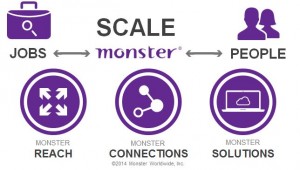 Careers publisher Monster Worldwide this morning outlined a sweeping new strategy that vastly expands its job offerings and the universe of candidates — by aggregating them from social sites and the Internet generally — and introduces new pricing models that will allow it to attract the smallest employer.
Careers publisher Monster Worldwide this morning outlined a sweeping new strategy that vastly expands its job offerings and the universe of candidates — by aggregating them from social sites and the Internet generally — and introduces new pricing models that will allow it to attract the smallest employer.
Monster’s Strategy Briefing conducted for investors, analysts, and others at company headquarters in Weston, Mass., is bold and, in the words of Chairman, President and CEO Sal Iannuzzi, “This is disruptive to everyone of our competitors.”
It puts the company in head-to-head competition with Indeed and other job aggregators, changes the game for job boards with the traditional pay to post pricing model, challenges LinkedIn, and even takes on low-priced, entry-level oriented Craigslist.
In the first 90 minutes of the briefing, company executives broadly described a three pillar strategy.
Pillar one it called Monster Reach, describes the company’s expansion of the number of jobs it offers to job seekers, and the increase in social media distribution and targeting of paid jobs.
Pillar two is Monster Connections, which is a significant broadening of the individuals “discoverable for sourcing.” These will come from collecting profiles and other candidate information from social networks and elsewhere on the Internet. Connections also includes new methods for directly communicating with those people.
Pillar three is Monster Solutions, the name given to its analytical tools, CRM and other cloud-based services.
Details on how all of these integrate and what each of the moving parts look like and how they will function wasn’t part of today’s presentation. It will take time to digest the plan and learn the specifics.
Iannuzzi said Monster teams will do roadshows in the coming weeks, with most of the new features and pricing rolling out in the U.S. on July 1. Europe will follow shortly after.
However, Monster’s CFO , James Langrock, described the financial implications of the new strategy, detailing the size of the market potential and the potential for boosting Monster’s financial performance within 24 months. He predicted that the company’s EBITDA (earnings Before Interest, Taxes, Depreciation and Amortization) would reach 35 percent, a significant improvement.
Much of the analysts’ questions at the end of the presentation focused on the financial implications, as well as seeking more detail on the specifics of the strategy, for the recruiting industry, the strategy marks a significant overhaul in the way Monster does business.
The company is clearly setting its sights on expanding into the long tail of employers, specifically mentioning Craigslist and its $25 (in some markets; $75 in metro markets) job ads. A new pay for performance model will make Monster attractive to the “pizza shop owner” who previously spent $25 on Craigslist, as one Monster official explained.
But the company’s new aggregation of online jobs puts it directly in pursuit of Indeed, the largest aggregator in the world, by shifting from a purely paid ad business model to one that will now include a mix of paid and free ads.
Here are the highlights of developments most directly affecting recruiters:
1. Monster will aggregate jobs from online sources all over the world. In the U.S. alone, jobs available on the site have already increased from 250,000 to 1.5 million in the last few months. By the end of the year, the total will reach about 4 million. Like the aggregators, these ads will appear in Monster’s search at no charge to the employer.
2. A pay for performance model is being added to the pricing mix. Monster will keep duration pricing — the traditional paid job model for the industry — adding a pay for performance option it expects will appeal to the smallest, price-conscious employer.
3. Customers will have more choices of where their paid ads appear, including social media sites. Twitter and Facebook were two sites specifically mentioned. These jobs ads, company officials explained, can be narrowly targeted and will be able to reach not only those individuals with a connection to the company (i.e. a company follower or fan), but others who fit the job profile.
4. The number of candidates in the Monster database is already growing “massively,” as one presenter described the increase from Monster’s aggregation of candidate data from the Web and from social media sites. Iannuzzi said recruiters now have access to 115 million profiles in the Monster database; enough millions more to bring the number to 200 million will be added in the coming weeks.